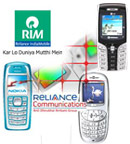
Anil Ambani-owned Reliance Communications (RCom) has finally got the green signal from government to allocate GSM spectrum in remaining 14 circles in India on Friday under Pan-India GSM mobile licence. Now Reliance can operate its GSM service in remaining 14 circles and can join the league of ‘National Footprint’ with Bharti Telecom that has already operating as a GSM operator in India’s all 22 circles. Reliance is already operating GSM services in eight circle of India.
Approving cross-over technology, Department of Telecommunication (DoT), has yesterday allotted 4.4 MHz of start up spectrum for 14-remaining circles to Reliance Communication. Now Reliance can operate both CDMA and GSM services in India covering a cross-over technology that permits mobile operators to operate both the service under single licence in a country with its own subsidiary Reliance Telecommunication that operates CDMA services.
Reliance Telecom has the largest CDMA network in India. While Tata Teleservices is on the second position in CDMA technology that have also got the ‘letter of intent’ form DoT for operating GSM services in 20 circles under the cross-over technology policy. However, Tata Teleservices has to wait for spectrum allocation as government is yet to allocate spectrum to those who had applied and deposited the fee in December 2006.
On the other hand, the existing GSM mobile operators Idea Cellular, Vodafone Essar, and Aircel have also been granted the start-up spectrum allocation of 4.4 Mhz in the those circles where they have already in operation with licences. Idea holds licences in 11 circles, Vodafone in 16 circles while Aircel in 9 circles.
Now IDEA can operate in 13 circles while Vodafone and Aircel with RCom will join the national footprint on Pan-India basis. Bharti (Airtel) and Vodafone that are waiting for additional spectrum allocation have also been granted in two circles as per sources reported. TRAI has announced to allocate additional spectrum to other operating companies within their operating circles very soon. As per TRAI (Telecom Regulatory Authority of India) regulation, additional spectrum will be allotted to those who crossed the recommended subscription in all areas (Metropolitan cities, Circle-A cities, Circle-B cities and Circle-C cities).
TRAI has recommended the higher frequency slabs - 8, 10, 12.4 and 15 MHz but DoT has not gone beyond 7.2 MHz. As per TRAI rule to be eligible for 7.2 MHz spectrum, a GSM operator needs 15 lakh users in a metro, 30 lakh in Circle A and B cities and 20 lakh in Circle C cities.
For CDMA players, the highest spectrum allocation has been recommended to only 5-MHZ frequency slab, to be eligible for it CDMA operators have to cross the recommended subscription of 20 lakh users in a metro, 50 lakh in circle A and B cities, and 40 lakh in a Circle C city.
Vodafone, Idea and Airtel had submitted the entry fee for additional spectrum allocation till December 2006 while Reliance Communication had submitted the fee on October 19, 2007 being the first among the 46 new applicants. Sources say that “government is favouring RCom” and the other operators have filed the case in Delhi High Court for challenging the ‘given spectrum allocation’. The next hearing is to be scheduled on Monday January 14, 2008.
But experts’ also assuming that the spectrum allotment to RCom may boost the competition among GSM players and there should be up to 30 percent price goes down from the current call rates.
RCom is expecting to play GSM with full capacity with next two months while its CDMA service will also be expecting to achieve similar target till year-end.
|
|
Read More: Delhi


Comments:
robin kumar saha
January 14, 2008 at 12:00 AM
'TRAI' should start allotment of national telephone/cell no to control service providers monopoly and people may change their service provider by recharging their plan on same number. ok , thanks